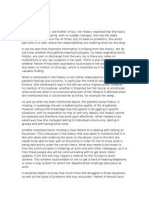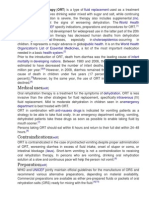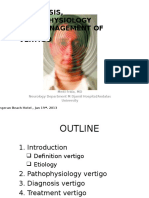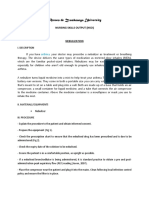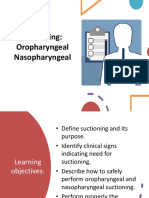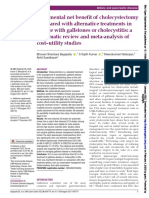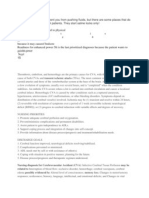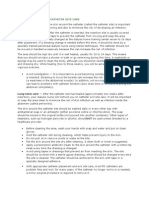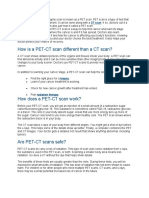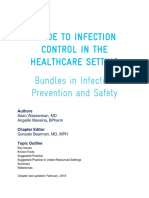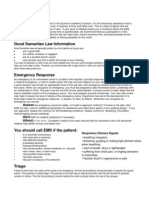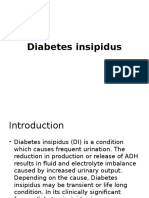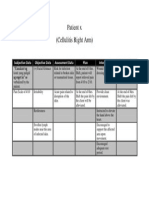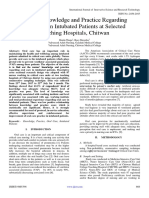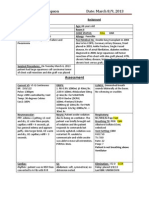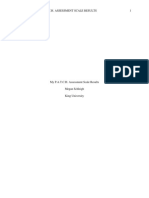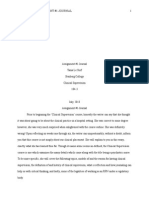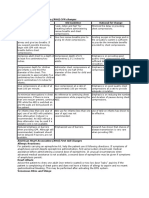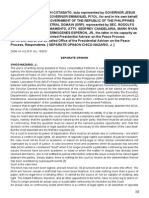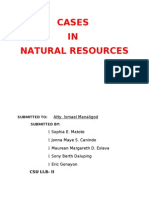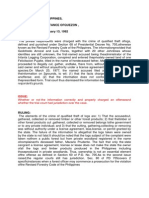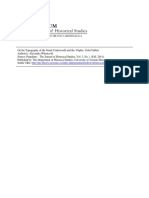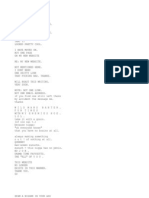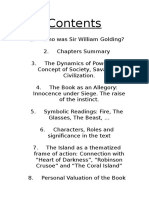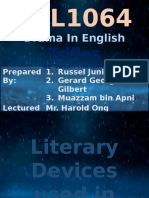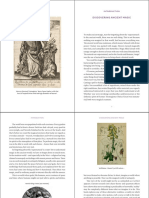CPR and FBAO Final Lecture
CPR and FBAO Final Lecture
Uploaded by
Ash CampiaoCopyright:
Available Formats
CPR and FBAO Final Lecture
CPR and FBAO Final Lecture
Uploaded by
Ash CampiaoOriginal Description:
Copyright
Available Formats
Share this document
Did you find this document useful?
Is this content inappropriate?
Copyright:
Available Formats
CPR and FBAO Final Lecture
CPR and FBAO Final Lecture
Uploaded by
Ash CampiaoCopyright:
Available Formats
CARDIOPULMONARY RESUSCITATION (CPR)
and
FOREIGN-BODY AIRWAY OBSTRUCTION
Kierstine O Garcia, RN
FO1 BFP
EMS STAFF
CHAIN OF SURVIVAL
CARDIOPULMONARY RESUSCITATION
FOREIGN-BODY AIRWAY OBSTRUCTION
CPR
CARDIOPULMONARY RESUSCITATION
1. Chain of Survival
Cardiopulmonary resuscitation (CPR) can save the lives of victims in cardiac arrest. Two
thirds of heart attack victims (due to heart disease) die outside the hospital, most within two
hours of the onset of symptoms. Though CPR itself is not enough to save the life of a victim of
heart attack, it is a vital link in the chain of survival.
The chain of survival has hour links, and the patients chances for surviving are the greatest
when all the links come together.
1. Early access
2. Early CPR
3. Early defibrillation
4. Early advanced life support
The need for these interventions should not be limited to victims of heart disease .Many
victims of drowning, trauma, electrocution, suffocation, airway obstruction, allergic reaction,
etc., may be saved by prompt intervention.
2. Heart Attack Risk Factors
Risk factors that cannot be changed (non-modifiable)
Heredity
Age
Gender
Risk factor that can be changed (modifiable)
Smoking
Hypertension
Exercise
High cholesterol
Contributing factors
Obesity
Diabetes
Stress
3. Breathing
Adequate breathing is characterized by:
Chest and abdomen rise and fall with each breath
Air can be heard and felt exiting the mouth and or nose
Inadequate breathing is characterized by:
Inadequate rise and fall of the chest
Noisy breathing:bubbles,rales,stridor,whistling,etc.,
Absent breathing is characterized by:
No chest or abdominal movement
Air cannot be heard or felt exiting the mouth or nose
4. Cyanosis
A bluish discoloration of the skin and the mucous membranes caused by a lack of oxygen in
the blood and tissues.
This condition can be the result of the patient breathing in an environment poor in oxygen,
suffering from illness or respiratory injury, or airway obstruction.
Cyanosis can be more easily noticed on the lips, ears and nostrils or nailbeds. In patients with
dark pigmentation, it is necessary to inspect the nostrils, palm, and nailbeds, and the mouth and
tongue.
5. Clinical and Biological Death
Clinical Death: Occurs when a patient is in respiratory arrest (not breathing)or in cardiac
arrest(heart not beating).The patient has a period of 4 to 6 minutes to be resuscitated without
brain damage. Clinical death can be reversed.
Biological Death: The moment the brain cells begin to die. Biological death cannot be reversed.
6. Signs of Certain Death
Lividity: pooling of blood from the lower areas of the body
Purple to bluish color
Rigormortis: Stiffening of body and limbs, occurs usually 4-10 hours after death.
Decomposition: the breakdown of substance into simpler chemical forms.
Other: Mortal wounds such as decapitation, severe crashing injuries
Technique for Opening the Airway
Head-Tilt Chin-Lift
Jaw Thrust
When opening the airway, use the correct method:
Medical case: (any part of the body is affected none in particular)
Head-Tilt Chin-Lift
Trauma case: (specified like head or neck injury)
Jaw Thrust
Head-Tilt Chin-Lift
This is the method of choice for opening the airway.
Do not use this method if you suspect head, neck or spinal injury.
1. Position the patient lying face up (supine position).
2. Kneel by the patients shoulder toward the head.
3. Place hand on the forehead and place the fingertips of your other hand under the bony
part of the patients jaw.
4. Lift on the chin, support the jaw, and at the same time, tilt the head back as far as
possible.
For infants and children: Place in the sniffing positiondo not over-extend.
Important Precautions:
Always keep the patients mouth slightly openuse your thumb to hold down the
patients lower lip.
Never dig into the soft tissue under the patients chin.
Once the airway is open, check breathing.Look, listen and feel. If patient is not breathing,
artificial ventilation should be started. If unable to ventilate, assume the airway is obstructed.
J aw Thrust
The jaw thrust is the only maneuver recommended on an unconscious patient with suspected
head, neck, or spinal injury.
1. Position the patient lying face up.
2. Kneel above the patients head. Place your elbows next to the patients head on the surface
where the patient is lying. Place both hands on either side of the patients head.
3. Grasp the angle of the patients jaw on both sides. For an infant or child use two or three
fingers.
4. Use a lifting motion to move the jaw forward (up) with both hands.
5. Keep the patients mouth slightly open by using your thumbs if needed.
Artificial Ventilation (Rescue Breathing)
Once the patient has an open airway, you can provide artificial ventilation for a patient
breathing inadequately or not at all.
How is it possible to maintain a patient alive with exhaled air? Natural air contains
approximately 21% oxygen and the body only utilises about 5%.Therefore,exhaled air contains
16%oxygen.This exhaled air can resuscitate a person who is not breathing, until a high-
concentration oxygen source is available.
Techniques for Artificial Ventilation
Mouth to mouth and nose
Mouth to mouth
Mouth to mouth
Mouth to stoma
Cardiopulmonary Resuscitation Management
1. Survey the scene, introduce and ask permission
2. Check for responsiveness
a. Tapping of shoulders (2x)
b. Calling of names
3. Shout for help or activate EMS if patient is unresponsive
4. If available get Automated External Defibrillator
5. Perform 30 chest compression for about 15-18 seconds
a. Proper position should be at the midsternum area of the chest
b. Always observe the proper depth of the compression not to deep
c. Allow the chest to return to its normal position
d. Position shoulders over hand with elbows lock and arm straight
e. Keep hand in contact with the chest all the times
6. Opening the airway (head-tilt, Chin-lift maneuver)
a. Proper position is observe
b. Hand on the forehead
c. Fingers on the chin
7. After every 30 chest compressions give two 1 second breath (1,1001,1,1002)
8. While giving ventilation observe:
a. Nose maintained pinch
b. Full slow breaths (1sec)x 2
c. Cover the whole mouth
9. Repeat cycles of chest compressions and 2 ventilations for 5 seconds (approximately 2
minutes)
10. Check the carotid pulse for 10 seconds every 2 minutes (equivalent to 5 cycles of CPR)
11. If pulse is positive and breathing is negative give artificial respirations:
a. Give one full breath every 5 seconds for 24 cycles (blow, 1,1002,1003,1001 up to 24
cycles)
12. While giving artificial ventilation:
a. Nose maintained pinch
b. Full slow breaths (1sec)x 2
c. Cover the whole mouth
13. Recheck the carotid pulse for 10 seconds
14. Place the patient in recovery position if pulse and breathing are both present.
CPR for Infant
1. Survey the scene, introduce and ask permission
2. Check for the infants responsiveness
a. Gently tap the bottom of the infants feet
b. Shout hey baby are you OK?
If there is no response
3. Ask someone to call EMS
4. Perform 30 chest compressions at about 15-18 seconds
a. Position two fingers on the compression area (one finger width below the
imaginary nipple line)
b. Depth of compression at 1/3 to
c. Allow the chest to return to its normal position
d. Maintain open airway with one hand while compressing the chest with two
fingers of the other hand.
e. Keep fingers at contact with the chest at all times.
5. Open the airway (head-tilt, chin-lift maneuver)
a. Proper head-tilt should be observe (neutral or slightly extended position)
b. Hand should be at the infants forehead
c. Fingers should be place at the infants chin
6. Give two puffs after each 30 compressions
7. While giving ventilation:
a. Slow breath 1 second x 2
b. Mouth seal over the infants mouth and nose
8. Repeat cycles of chest compressions and 2 ventilations for 5 cycles (approximately
for 2 minutes)
9. Check the brachial for 10 seconds every 2 minutes (equivalent to 5 cycles of CPR)
10. If pulse is positive and breathing is negative give artificial respiration:
Give 1 breath every 3 seconds for 40 cycles (blow, 1, 1001 up to 40 cycles)
11. While giving ventilation:
a. Slow breath 1 second x 2
b. Mouth seal over the infants mouth and nose
12. Recheck the brachial pulse for 10 seconds
13. Place the infant in recovery position if the pulse and breathing is present.
Recognizing Foreign Body Airway Obstruction (FBAO)
Foreign-Body Airway Obstruction
Foreign-body airway obstruction should be considered in any victimespecially
a younger victim who suddenly stops breathing, becomes cyanotic, or loses
consciousness for no apparent reason.
Two types of FBAO:
Partial:
An object caught in the throat that does not totally block breathing. A patient with
partial obstruction may have adequate or poor air exchange. With adequate air
exchange, the patient may cough forcefully, though there may be wheezing
between coughs. Do not interfere with patients attempt to clear the airway. With
poor air exchange ,the patient will exhibit a weak, ineffective cough, high pitched
noise while inhaling, increased respiratory difficulty and possible cyanosis. Treat
this situation as a complete airway obstruction.
Complete
The patient is unable to speak, breath, or cough. May clutch the neck with thumb and
finger. Air movement will be absent.
Heimlich maneuver
The Heimlich maneuver (sub diaphragmatic abdominal thrusts) is
recommended for relieving foreign-body airway obstruction. By elevating the
diaphragm, the Heimlich maneuver can force air from the lungs to create an
artificial cough intended to expel a foreign body obstructing the airway. Each
individual thrust should be administered with the intent of relieving the
obstruction. It may be necessary to repeat the thrust several times to clear the
airway. Five thrusts per sequence is recommended.
When you perform this maneuver, you should guard against damage to internal
organs, such as rupture or laceration of abdominal or thoracic viscera. To minimize this
possibility, your hands should never be placed on the xiphoid process of the sternum or on the
lower margins of the rib cage. They should be below this area but above the navel and in the
midline. Regurgitation may occur as a result of abdominal thrusts. Be prepared to position
the patient so aspiration does not occur.
HEIMLICH MANEUVER WITH VICTIM STANDING OR SITTING.
To perform the Heimlich maneuver with victim standing or sitting, stand behind the
victim, wrap your arms around the victims waist, and proceed as follows:
Step 1Make a fist with one hand.
Step 2Place the thumb side of the fist against the victims abdomen, in the midline slightly
above the navel and well below the tip of the xiphoid process.
Step 3Grasp the fist with the other hand and press the fist into the victims abdomen with a
quick upward thrust.
Step 4Repeat the thrusts and continue until the object is expelled from the airway or
the patient becomes unconscious.
Each new thrust should be a separate and distinct movement
HEIMLICH MANEUVER WITH VICTIM LYING DOWN.
To perform the Heimlich maneuver with victim lying down, proceed as follows:
Step 1Place the victim in the supine position (face up).
Step 2Kneel astride the victims thighs and place heel of one hand against the victims
abdomen, in the midline slightly above the navel and well below the tip of the xiphoid.
Step 3Place the second hand directly on top of the first.
Step 4Press into the abdomen with a quick upward thrust.
Responsive Adult/Child
1. Introduce, ask for consent and determine complete or partial airway obstruction
2. Get in position, stand behind the patient and place one leg between the patients leg
3. Reach around and locate the navel
4. With the other hand, make a fist and place it against the abdomen, thumb side in, just
above the navel
5. Grasp your fist with the first hand and give up to five abdominal thrust/Heimlich
Maneuver in quick inward and upward direction
6. Observe, the patient will cough or speak if the object is removed or dislodged
7. If still obstructed repeat the thrust until the airway is clear or the patient becomes
unconscious.
Unresponsive Adult/Child
1. Place the patient into supine position
2. Activate EMS
3. Open the airway using the appropriate technique (head-tilt, chin-lift)
4. Assess breathing for ten (10) seconds
5. Attempt to provide one full slow breath
6. If unable to provide adequate chest rise/air bounces back, reposition the head
7. Give again one full slow breath
8. If air still bounces back, give thirty (30) chest compressions
9. Check airway, if obstruction is visible perform finger sweep. If obstruction is not visible
go back to step number 5
10. If object was removed and patient still unconscious:
a. Give two (2) confirmatory blows
b. Check breathing for ten (10) seconds
c. If breathing is adequate, put the patient into recovery position
11. If object was removed and patient becomes conscious, put him/her into recovery position
(side lying).
FBAO in I nfant
1. Survey the scene, introduce and ask permission
2. Pick up the infant and determine if partial or complete obstruction:
a. No strong cry
b. Weak, ineffective cough
c. Difficulty of breathing
3. Support the infants head as you place him down on your forearm. Use your thigh to
support your forearm. Keep the infants head lower than the body.
4. Rapidly deliver 5 back blows just between the shoulder blades. If this fails to expel the
object proceed to the next step.
5. While supporting the infant between your forearms, turn him over onto his back. Perform
5 chest thrust (at about 15-18 seconds).
a. Position two fingers on the compression area (one finger width below the imaginary
nipple line)
b. Depth of compression at 1/3 to
c. Allow the chest to return to its normal position
d. Maintain open airway with one hand while compressing the chest with two fingers of
the other hand.
e. Keep fingers at contact with the chest at all times.
6. Continue with this sequence of back slaps and chest thrust until the object is expelled or
the infant loses consciousness
Unresponsive I nfant
1. Position the infant lying face up, the open the airway by placing the infants head in
neutral or sniffings position
2. Activate EMS if you are not alone (ask someone to call for help)
3. Check breathing for 10 seconds. Open the airway (head-tilt, chin-lift maneuver)
a. Proper head-tilt should be observe (neutral or slightly extended position)
b. Hand should be at the infants forehead
c. Fingers should be place at the infants chin
4. If there are no signs of breathing attempt to ventilate.
a. Slow breath 1 second x 2
b. Mouth seal over the infants mouth and nose
5. If air bounce back reposition the head and ventilate again.
6. If still bounces back proceed to the next procedure
7. Perform 30 chest compressions
8. Open the airway and look for the object. If the object is not visible repeat step 4
9. If the object is visible, do finger sweep. If object is removed proceed
10. Provide two (2) confirmatory blows
11. Check breathing for 10 seconds
12. Place infants into recovery position if infants coughed or becomes responsive.
You might also like
- Extra Judicial Settlement With WaiverDocument3 pagesExtra Judicial Settlement With WaiverAtty Reynan Dollison80% (10)
- DisinheritanceDocument3 pagesDisinheritanceAnonymous ubixYA80% (5)
- BFP SOPonFireandArsonInvestigationDocument9 pagesBFP SOPonFireandArsonInvestigationhailglee192563% (8)
- Otosclerosis Case StudyDocument3 pagesOtosclerosis Case StudySana Anwar0% (2)
- MS 3 Case Analysis DownloadableDocument1 pageMS 3 Case Analysis DownloadableCharissa Magistrado De LeonNo ratings yet
- Nursing Research, Nursing Research, Nursing Research, Nursing Research, Leadership and Leadership and Leadership and Leadership andDocument18 pagesNursing Research, Nursing Research, Nursing Research, Nursing Research, Leadership and Leadership and Leadership and Leadership andKim RamosNo ratings yet
- Isip V PeopleDocument3 pagesIsip V PeopleAsh Campiao50% (2)
- An Introduction To Der Ring Des NibelungenDocument34 pagesAn Introduction To Der Ring Des NibelungenTarlan Fisher67% (3)
- Romanovs StudentDocument11 pagesRomanovs Studentapi-195601294No ratings yet
- Natural DeathDocument16 pagesNatural DeathPaul Harrison100% (2)
- Basic Concepts To Basic Life SupportDocument8 pagesBasic Concepts To Basic Life SupportHynne Jhea EchavezNo ratings yet
- Nursing Care PlanDocument26 pagesNursing Care PlanPrincessLienMondejarNo ratings yet
- Oral Rehydration TherapyDocument7 pagesOral Rehydration TherapyBala MuruganNo ratings yet
- Hematology and Systemic Pathology - Paper IIDocument1 pageHematology and Systemic Pathology - Paper IIrichuNo ratings yet
- NURSING CASE PRESENTATION NewDocument6 pagesNURSING CASE PRESENTATION NewHardeep KaurNo ratings yet
- Administering Pulse OxDocument2 pagesAdministering Pulse OxjepoiNo ratings yet
- Health Assessment - General SurveyDocument73 pagesHealth Assessment - General Surveymamiyo71No ratings yet
- NCPDocument10 pagesNCPCristina L. JaysonNo ratings yet
- Diagnosis, Pathophysiology and Management of VertigoDocument32 pagesDiagnosis, Pathophysiology and Management of VertigoKarina SuandraNo ratings yet
- START / Jump START Triage: ImmediateDocument2 pagesSTART / Jump START Triage: ImmediateJerome DanielNo ratings yet
- MCN PretestDocument16 pagesMCN PretestrikidbNo ratings yet
- Ecg ProcedureDocument5 pagesEcg ProcedureLungu AdrianNo ratings yet
- Journal BurnDocument4 pagesJournal BurnDannah TagulaoNo ratings yet
- Ateneo de Zamboanga University: Nursing Skills Output (Nso)Document9 pagesAteneo de Zamboanga University: Nursing Skills Output (Nso)Mitzi BelamideNo ratings yet
- Dec 21 23 Case Study ModuleDocument7 pagesDec 21 23 Case Study ModuleKristian Karl Bautista Kiw-isNo ratings yet
- Nifedipine Uses, Dosage & Side EffectsDocument6 pagesNifedipine Uses, Dosage & Side EffectsXICMENNo ratings yet
- Applying A Cardiac MonitorDocument3 pagesApplying A Cardiac MonitorLi Luren Raphaelle S. TanNo ratings yet
- NVS Written ReportDocument20 pagesNVS Written ReportbabiNo ratings yet
- MS Case PresDocument54 pagesMS Case PresShaine_Thompso_6877No ratings yet
- Assessment Diagnosis Planning Implementation Rationale EvaluationDocument14 pagesAssessment Diagnosis Planning Implementation Rationale EvaluationJennifer ArdeNo ratings yet
- ORO-NASO SuctioningDocument20 pagesORO-NASO Suctioningcaitie miracleNo ratings yet
- E000779 FullDocument19 pagesE000779 Fullmartina silalahiNo ratings yet
- NCP of CavDocument3 pagesNCP of CavHenry Roque TagalagNo ratings yet
- Bed Sore: - Presented ByDocument23 pagesBed Sore: - Presented BySWAPNIL WANJARINo ratings yet
- Peritoneal Dialysis WK 6Document3 pagesPeritoneal Dialysis WK 6Reem NurNo ratings yet
- TonsillectomyDocument6 pagesTonsillectomyBen David0% (1)
- Dehydration - Background, Pathophysiology, EpidemiologyDocument4 pagesDehydration - Background, Pathophysiology, EpidemiologyAri GunawanNo ratings yet
- Peritoneal DialysisDocument5 pagesPeritoneal DialysisLisette TupasNo ratings yet
- OPD GuideDocument1 pageOPD GuideAbdul BasitNo ratings yet
- Pet CTDocument4 pagesPet CTKanishk R.SinghNo ratings yet
- Week 2 - Ms1 Course Task - Cu 2Document3 pagesWeek 2 - Ms1 Course Task - Cu 2jaira magbanuaNo ratings yet
- Cranial Nerves Assessment FormDocument3 pagesCranial Nerves Assessment FormCristina CenturionNo ratings yet
- Bundles in Infection Prevention and SafetyDocument15 pagesBundles in Infection Prevention and SafetyInfectologia DiagnosticaNo ratings yet
- Annex I Summary of Product CharacteristicsDocument28 pagesAnnex I Summary of Product CharacteristicsEmma SinNo ratings yet
- Intracerebral HemorrageDocument13 pagesIntracerebral HemorrageChristian JuarezNo ratings yet
- BurnsDocument9 pagesBurnsVincentus BinNo ratings yet
- Basic First AidDocument14 pagesBasic First AidSLCNtcNo ratings yet
- Principles of Aseptic TechniqueDocument3 pagesPrinciples of Aseptic TechniqueDane CaumeranNo ratings yet
- Anti - Anginal MedicationDocument41 pagesAnti - Anginal MedicationShine StephenNo ratings yet
- KMB Diabetes InsipidusDocument24 pagesKMB Diabetes InsipidusNur Rofikoh Bil Karomah100% (1)
- Patient X (Cellulitis Right Arm) : Subjective Data Objective Data Assessment Data Plan Intervention EvaluationDocument1 pagePatient X (Cellulitis Right Arm) : Subjective Data Objective Data Assessment Data Plan Intervention EvaluationJhevilin RMNo ratings yet
- Nurses' Knowledge and Practice Regarding Oral Care in Intubated Patients at Selected Teaching Hospitals, ChitwanDocument8 pagesNurses' Knowledge and Practice Regarding Oral Care in Intubated Patients at Selected Teaching Hospitals, ChitwanAnonymous izrFWiQNo ratings yet
- Procedure Checklist Chapter 19: Assessing The Ears and HearingDocument2 pagesProcedure Checklist Chapter 19: Assessing The Ears and HearingjthsNo ratings yet
- Health Promotion of The ElderlyDocument16 pagesHealth Promotion of The ElderlyCarloAragonNo ratings yet
- Unang YakapDocument3 pagesUnang YakapChristelle LiNo ratings yet
- Careplan IsbarDocument3 pagesCareplan IsbarAmanda SimpsonNo ratings yet
- Running Head: My P.A.T.C.H. Assessment Scale Results 1Document4 pagesRunning Head: My P.A.T.C.H. Assessment Scale Results 1api-482726932No ratings yet
- Presentation On Sequential Compression DevicesDocument11 pagesPresentation On Sequential Compression Devicesumeshchandra24276No ratings yet
- Nursong ResponsibilitiesDocument4 pagesNursong ResponsibilitiesMichaela JapsayNo ratings yet
- 104-3 Journaling EssayDocument6 pages104-3 Journaling Essayapi-288504264No ratings yet
- Management of Patients With Upper Respiratory Tract DisordersDocument93 pagesManagement of Patients With Upper Respiratory Tract DisordersErica Clerigo Landicho100% (1)
- American Heart Association (AHA) CPR Changes: New Guideline Old Guideline Rational For ChangeDocument3 pagesAmerican Heart Association (AHA) CPR Changes: New Guideline Old Guideline Rational For ChangeMc Alaine LiganNo ratings yet
- NCP GeriaDocument6 pagesNCP GeriaKeanu ArcillaNo ratings yet
- Simple Triage and Rapid TreatmentDocument9 pagesSimple Triage and Rapid TreatmentGung IndrayanaNo ratings yet
- Nursing Care PlanDocument53 pagesNursing Care PlanAsma Alsaket100% (1)
- The Ride of Your Life: What I Learned about God, Love, and Adventure by Teaching My Son to Ride a BikeFrom EverandThe Ride of Your Life: What I Learned about God, Love, and Adventure by Teaching My Son to Ride a BikeRating: 4.5 out of 5 stars4.5/5 (2)
- Cardiopulmonary Resuscitation PresentationDocument29 pagesCardiopulmonary Resuscitation PresentationolelNo ratings yet
- Bureau of Fire Protection - ARMM: Basic First AidDocument50 pagesBureau of Fire Protection - ARMM: Basic First AidAsh CampiaoNo ratings yet
- BPAT April 2Document3 pagesBPAT April 2Ash CampiaoNo ratings yet
- Indices DNL: Slight Underperformance in 1Q15 On Lingering Effects of Port CongestionDocument10 pagesIndices DNL: Slight Underperformance in 1Q15 On Lingering Effects of Port CongestionAsh CampiaoNo ratings yet
- Ignition Temperature (Temperature Needed To Burn), and If There Is Enough Oxygen Present, TheDocument24 pagesIgnition Temperature (Temperature Needed To Burn), and If There Is Enough Oxygen Present, TheRalph CelesteNo ratings yet
- LANDBANK Iaccess FAQsDocument16 pagesLANDBANK Iaccess FAQsAsh Campiao100% (1)
- PhilHealth ClaimForm1 GuidelinesDocument4 pagesPhilHealth ClaimForm1 GuidelinesAsh CampiaoNo ratings yet
- Leg MedDocument12 pagesLeg MedAsh CampiaoNo ratings yet
- Legal Ethics and Practical Exercises - I - (10%) What Are The Duties of An Attorney?Document7 pagesLegal Ethics and Practical Exercises - I - (10%) What Are The Duties of An Attorney?Ash CampiaoNo ratings yet
- Separate Opinion Chico-Nazario, J.Document4 pagesSeparate Opinion Chico-Nazario, J.Ash CampiaoNo ratings yet
- Law On Natural Resources ReviewerDocument130 pagesLaw On Natural Resources ReviewerAsh CampiaoNo ratings yet
- A. PersonsDocument18 pagesA. PersonsAsh CampiaoNo ratings yet
- Foz Vs PeopleDocument2 pagesFoz Vs PeopleAsh Campiao100% (1)
- PP Vs Cfi l-46772Document2 pagesPP Vs Cfi l-46772Ash CampiaoNo ratings yet
- Digested Case in NatresDocument176 pagesDigested Case in NatresJonna Maye Loras Canindo100% (4)
- PP Vs Cfi l-46772Document5 pagesPP Vs Cfi l-46772Ash CampiaoNo ratings yet
- Learn To Play Go Volume 4Document176 pagesLearn To Play Go Volume 4Cenk Aslan100% (1)
- Pathophysiology DrowningDocument13 pagesPathophysiology DrowningIndah HaneNo ratings yet
- Smite Bellona Build Guide BellonaS8 Solo Build SMITEFireDocument1 pageSmite Bellona Build Guide BellonaS8 Solo Build SMITEFiregabriel montoya santestebaNo ratings yet
- Glory Be To God The FatherDocument1 pageGlory Be To God The FatherLei Z.No ratings yet
- List of Unusual DeathsDocument55 pagesList of Unusual DeathsDan VasileNo ratings yet
- Butte v. Manuel Uy Sons Inc.Document11 pagesButte v. Manuel Uy Sons Inc.Dino Bernard Lapitan100% (1)
- Alexandra Wheatcroft - On The Topography of The Greek Underworld and The Orphic Gold TabletsDocument9 pagesAlexandra Wheatcroft - On The Topography of The Greek Underworld and The Orphic Gold TabletsNenad JovanovićNo ratings yet
- August 23 - 2013. Old Website. Writing. Joey Alizio JRDocument14 pagesAugust 23 - 2013. Old Website. Writing. Joey Alizio JRJoseph Anthony Alizio jrNo ratings yet
- Ingles Juridico 1 Pregunta #1 ADocument6 pagesIngles Juridico 1 Pregunta #1 ACyber-Planeta San JuanNo ratings yet
- Ancient Egypt PPT Lecture 1Document19 pagesAncient Egypt PPT Lecture 1Anuj MauryaNo ratings yet
- Sonnets: Definition: Originated in Middle Ages, Iambic Pentameter, Always 14 Lines Long, May Be Either Petrarchan orDocument3 pagesSonnets: Definition: Originated in Middle Ages, Iambic Pentameter, Always 14 Lines Long, May Be Either Petrarchan orStephen ChartrandNo ratings yet
- Wills 2nd ReviewerDocument5 pagesWills 2nd ReviewerronaldNo ratings yet
- Determinants of Early Childhood Deaths in Agusan Del SurDocument32 pagesDeterminants of Early Childhood Deaths in Agusan Del SurRa PhaNo ratings yet
- Virtual Class SCORM E4 U3Document26 pagesVirtual Class SCORM E4 U3jesus saanchezNo ratings yet
- Another Dolphin Killed by SelfieDocument2 pagesAnother Dolphin Killed by SelfievericliNo ratings yet
- KARG - (Ravenloft) Quoth The Raven #23Document82 pagesKARG - (Ravenloft) Quoth The Raven #23David CullifordNo ratings yet
- Lord of The FliesDocument22 pagesLord of The FliesMuhammad IrfanNo ratings yet
- 7.my Mother at Sixty-Six-2Document2 pages7.my Mother at Sixty-Six-2ococ yamaysaharNo ratings yet
- Death Penalty ProsDocument1 pageDeath Penalty ProsAna Maria AyalaNo ratings yet
- Luke 16-22-27 A Parable About Me (2) - Don't Be SurprisedDocument7 pagesLuke 16-22-27 A Parable About Me (2) - Don't Be SurprisedDave McNeffNo ratings yet
- Methought I Saw My Late Espoused Saint - British Literature WikiDocument2 pagesMethought I Saw My Late Espoused Saint - British Literature WikiAntonia YoungNo ratings yet
- Top Ten Scenes From SCREAM 4Document3 pagesTop Ten Scenes From SCREAM 4Xypear SummerzNo ratings yet
- Destiny and FateDocument1 pageDestiny and FateTalon BloodraynNo ratings yet
- Drama in English: TriflesDocument23 pagesDrama in English: TriflesRussel Jr JuliusNo ratings yet
- Productattachments Files Ancient Magic PrePDF DraggedDocument16 pagesProductattachments Files Ancient Magic PrePDF DraggedChristine GelNo ratings yet



